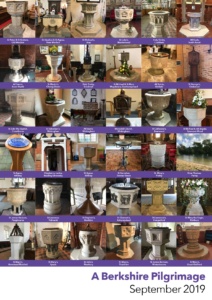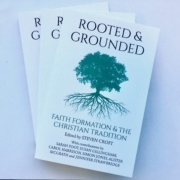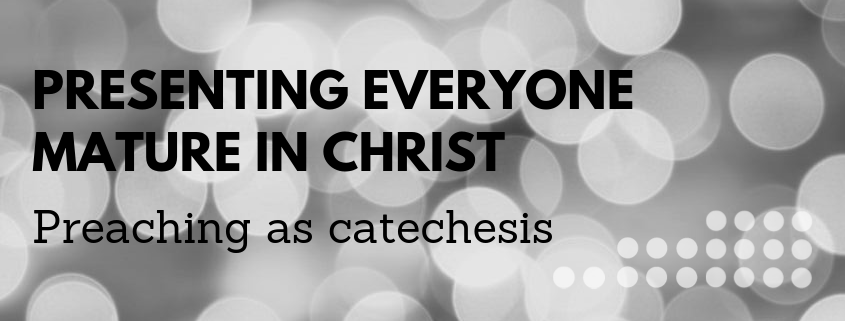This week over 400 people gathered in Christ Church for the Festival of Preaching. The conference was fully booked with a waiting list and a very high level of energy. There excellent and moving contributions from a galaxy of great speakers including our Dean, Martyn Percy, Brian MacLaren, Paula Gooder, Margaret Whipp and others. Below is my contribution, but look out for the others and talk to those who were there.
1.
Paul writes in Colossians:
“It is Christ whom we proclaim, warning everyone and teaching everyone in all wisdom, so that we might present everyone mature in Christ. For this I toil and struggle, with all the energy that he powerfully inspires within me” (Colossians 1.28-29).
St Paul sets out the central goal of Christian preaching: forming people into the likeness of Christ and into Christian maturity. This formation and preaching is centred on presenting Christ: It is Christ whom we proclaim. This is the Christ of creation and redemption unfolded in the great Colossians hymn in 1.15-20. This is both human labour and enterprise: for this, I toil and struggle. It is also a work which goes beyond human skill and flows from the energy which the God the Spirit inspires within me.
Catechesis, formation into Christ and into maturity, is central to early Christian preaching. The same picture is reflected in the narrative of Acts. Paul’s ministry in Ephesus is focussed around daily dialogue in the Hall of Tyrannus for two years (Acts 19.8-10). In Acts 20, Luke shows us Paul looking back to that ministry, teaching publicly and from house to house (20.20). Paul asks the Ephesian ministers to remember that “I did not cease day and night to warn everyone with tears”. This is a demanding passionate ministry, centred around forming individuals and the Church into the likeness of Christ.
2.
As the Church in this diocese, we discern that our calling is a simple one: we are called to be a more Christ-like Church for the sake of God’s world: more contemplative, more compassionate and more courageous. One of the central outworkings of that vision is the renewal of catechesis across the diocese: the cluster of disciplines centred around baptism: the welcome and nurture and teaching of children and families and young people so as to present every person mature in Christ.
 Last week I was on a pilgrimage of prayer across Berkshire. I visited almost 40 churches travelling by boat, by foot and by bike. In every church I took a picture of the font and we prayed together for the renewal of all the ministry which flows into and out of the font: the welcome of young children whose parents have just enough faith to bring them to baptism; all the teaching and nurture of children and young people; walking with enquirers and new believers to bring them to baptism and confirmation; enabling the whole church to live out our baptism in every part of our lives.
Last week I was on a pilgrimage of prayer across Berkshire. I visited almost 40 churches travelling by boat, by foot and by bike. In every church I took a picture of the font and we prayed together for the renewal of all the ministry which flows into and out of the font: the welcome of young children whose parents have just enough faith to bring them to baptism; all the teaching and nurture of children and young people; walking with enquirers and new believers to bring them to baptism and confirmation; enabling the whole church to live out our baptism in every part of our lives.
Almost everyone I have ever worked with has tried to persuade me not to use the word catechesis in public. It’s not the most accessible of words. But it is deeply rooted in the Christian tradition and describes a cluster of ministries and practices around Christian formation and supporting enquirers as they explore faith and come to baptism and learn all of what the Christian church means.
At the centre of the word catechism is the word echo. In the words of John Chrysostom, we are seeking to form an echo of the living word of God, Jesus Christ, in the heart and life of every believer.
The whole church needs a recovery and renewal of catechesis in our day. According to the recent British Social Attitudes survey, 52% of people in the United Kingdom are now of no religion: that proportion is far greater among the under 30’s. It seems to me that we are called now to become again a deeper church, mature in Christ, and that is more important than becoming a larger church, to serve our society well and to hand on the faith to the next generation.
 If we are to become a deeper Church then we must seek the renewal of catechesis informed by scripture and by the great tradition. This week sees the publication of a new book, Rooted and Grounded, which it’s been my privilege to edit. Six Oxford theologians have taken a deep dive into the tradition and explore what we can learn from catechesis in earlier generations: Sue Gillingham writes on the Psalms and Jennifer Strawbridge on the early Christian creeds; Carol Harrison writes on the patristic period and Sarah Foot on Anglo Saxon catechesis. Simon Jones focusses on the connections between liturgy and formation and Alister McGrath on the abiding importance of the creeds. I commend it to you.
If we are to become a deeper Church then we must seek the renewal of catechesis informed by scripture and by the great tradition. This week sees the publication of a new book, Rooted and Grounded, which it’s been my privilege to edit. Six Oxford theologians have taken a deep dive into the tradition and explore what we can learn from catechesis in earlier generations: Sue Gillingham writes on the Psalms and Jennifer Strawbridge on the early Christian creeds; Carol Harrison writes on the patristic period and Sarah Foot on Anglo Saxon catechesis. Simon Jones focusses on the connections between liturgy and formation and Alister McGrath on the abiding importance of the creeds. I commend it to you.
Catechesis involves a range of different disciplines: working with individuals and families, as Paul writes. Working with small groups of people in different contexts. There is much we can learn about forming good habits of prayer, about liturgical welcome and celebration of the sacraments, about incorporating people into the community; about the pastoral care of new Christians.
But this is a Festival of Preaching. My purpose today is to focus on the connections between the ministry of preaching in the life of the Church and Christian formation or catechesis. What role should our preaching play in this work of Christian formation? What can we learn from the practice of the Church down the centuries? How should we connect preaching and catechesis in the 21st century?
3.
Preaching and public proclamation has always played a role in catechesis. From earliest times, public preaching in the main assembly of the Church, at the eucharist, serves to expound the faith for beginners as well as for the mature disciple. In some churches in some periods the enquirers, the catechumens, are a distinctive group, and the preacher will turn to address them, especially in certain seasons of the year. But all of the time, preaching is open and accessible, addressing the person on the edge of and beyond the congregation as well as the believer. We have examples from the patristic period of single sermons and series of sermons addressed largely to those enquiring about faith. Augustine provides two example sermons to the deacon Deogratias in his book On Instructing beginners in the faith. Cyprian, Bishop of Carthage in the third century, has left us a whole series of sermons on the Lord’s Prayer in which he unfolds the entire gospel through a single text.
In the Anglo Saxon period, England was evangelised by monks who established deep places of faith and prayer and travelled from there to preach and baptise new believers. The core of their teaching as in the patristic period is the Creed and the Lord’s Prayer. In 1281, in the Middle Ages, the bishops of England met at Lambeth and issued a decree. The clergy were to expound the Christian faith in every parish no fewer than four times a year. This is an era before printed books and literacy. The syllabus, according to Eamon Duffy, consists of the Apostles Creed and the Lord’s Prayer, the Commandments, the seven works of mercy, the seven vices, the seven virtues and the seven sacraments.
Communication and formation changed at the Reformation because technology and education changed with the invention of printing. The English clergy faced the challenge of expounding the faith of the Church in different ways and to help them understand the scriptures, now translated into English and available in every church. The central texts remain the Creed, the Lord’s Prayer and the commandments now folded into the Prayer Book catechism. Every minister is obliged to teach the catechism in his parish. Every minister’s first task following his ordination was to write and preach his catechetical sermons expounding the whole faith. The traditional theological syllabus in the Universities is geared towards enabling the clergy to expound the faith in this way. Catechesis is a central concern of the English clergy in a way which is often not the case today. I believe we need urgently to set again the desire to present every person mature in Christ at the centre of our preaching and teaching.
4.
But how are we to do that? The challenge is significant. The water table of knowledge and understanding of the Christian faith falls with each generation. Our preaching clearly needs to be open and accessible. It needs to address the questions people are asking. Our preaching needs to provoke thought and questions as well as provide answers. We must not assume too much in terms of knowledge, but nor must we talk to people as if they are children. We must offer good news but acknowledge also the pain and difficulty and questions and suffering in many people’s lives.
We must know and understand our congregations. Good preaching is one half of a dialogue. The preacher’s address to the congregation will be based on hours of listening not only to the scriptures but to the people in his or her care. And not only to the people in his or her cure of souls, but to the wider culture. What are themes and the issues? What can I say which will build a good bridge of communication between us and establish trust and gain a hearing?
We must use language which is accessible to our congregations and communities. Too many sermons miss their mark because life-giving truth is obscured by language that is too dense or insufficiently thought through.
Luke tells us over and over again in Acts that the apostles proclaimed the gospel with boldness. The term does certainly carry the meaning of courageous in the face of opposition. But it carries also the term “transparent, open and plain speaking”. How many of us I wonder have had the experience of preaching to an all-age service, thinking we are addressing the children, and have received the most positive feedback from adults because that is the only sermon in the month which our congregations can access?
5.
I want to focus the relationship between preaching and catechesis in a single area, if I may: the dynamic resource which is the Christian year, the cycle of the seasons.
The notion of the Christian year evolves in Christian history as the Church explores the relationship between preaching in the context of liturgy and catechesis, Christian formation. Easter became the central focal point for adult baptism: we die with Christ and rise again. Baptism at Easter is preceded by 40 days of intense preparation. Lent then emerges from the catechetical needs of the church. The period before Lent, the Epiphany season, then becomes a time of invitation: who will take the step of enrolling to be baptised this year? The period after Easter becomes a time for the deepening of faith.
The long story of salvation history finds its mirror in the liturgical cycle of the Church’s year; the gospel is summarised in the Apostle’s Creed and that Creed is taught in an annual cycle of Christian formation.
It is common in the ancient world and now for someone to be part of the community for several cycles before active faith is stirred and awakened and the person enters fully into the Christian way as a disciple. Once a person has learned the faith for the first time and come to baptism and confirmation, then year by year that faith and understanding are deepened within the framework of the great story of salvation lived out and expressed in our liturgy. The story is revisited over and over again at different stages of life and of faith development.
Rowan Williams expressed all of this more eloquently than I in an address on fresh expressions and the sacramental tradition around ten years ago:
“Every year (the great drama of salvation) is re-enacted. We begin by imagining ourselves in the world before Christ, longing for a release, a new horizon, a world of liberation whose nature we don’t yet know. We celebrate the miracle of God arriving in flesh and blood in our world and we trace his path through struggle and suffering to death, trying to shift our perspectives and change our priorities…..so that we see all this as the way into life and out of falsehood.
“We receive the shattering news that death cannot contain the flesh and blood of Jesus and cannot end the life-giving relationships he creates. And we find that in the community where these relationships are recognised and thought about and lived out, we learn how to relate to God the Father as Jesus does and to understand that each of us is necessary to the life of the other – the communion of the Holy Spirit. Into this annual course of discovery we put our particular concerns and changes and new perspectives, and it dawns on us slowly that we are finding out who we are by finding out who Jesus is – and vice versa” [i]
The sermon is essential in drawing out this annual cycle of formation. The Church Year and the lectionary are there to support our year by year exploration of the faith, the work of Christian formation, as we address in our preaching enquirers and Christians already on the Way. Let’s take that thought and unpack it further into a framework for preaching and catechesis for our own day.
6.
The centre of this annual cycle of formation is Easter Day: the day of resurrection; the day of joy; the day of baptism and the renewal of baptismal promises.
It is preceded by Lent: the period of preparation for baptism. This is the season above all to explore the heart of the gospel and the core texts of the gospel for the sake of those we are accompanying to baptism and for the whole church.
For this, it is essential to grasp the core shape of the Christian faith in terms of our learning. The Christian faith is not a faith in which you progress through knowledge to greater and deeper stages of initiation and membership. You begin with the basics and then do something more advanced and so on and so forth. There have been distortions of the Christian faith all down the centuries which have been shaped in that way. In the New Testament and early church period, those systems were called Gnosticism. Our salvation comes through knowing.
The Christian faith is about being centred in Christ and the death and resurrection of Christ and baptism. The Letter to the Colossians has the great baptismal images at its centre: death and resurrection; putting off and putting on. The central verse of Colossians is 2.6-8. The writer is combatting a move to urge the Colossians to move on to so-called deeper, more esoteric things. He does this by exposing the centred nature of the faith.
“As you therefore have received Christ Jesus the Lord, continue to live your lives him him, rooted and built up in him and established in the faith, just as you were taught, abounding in thanksgiving.
Lent in my view is not a season for going further for the church in our knowledge, but a season for re-centering our lives upon the gospel, the death and resurrection of Christ. The four great catechetical texts, the Lords’ Prayer, the Creed, the Commandments and the Beatitudes are ideal for the whole Church to focus on in Lent, with those preparing for baptism. The new series of Lent Pilgrim and Easter Pilgrim material this year was an attempt to do that in individual guided reflections.
It is followed by the Easter season, a time for those who have been baptised to reflect on the deepening of their own faith in the sacramental life of the Church and on the living out of our discipleship in the world.
Go back a stage before Lent, to Epiphany, and we have a season of invitation beginning with remembering the baptism of Christ.
That leaves the autumn as a season for proclaiming the great universal themes of the gospel.
The whole year then forms a cycle of catechesis, of evangelism and nurture, welcoming those who are new to the faith, and of helping the whole Church deepen our encounter with the living Christ.
We begin the cycle in September with the season of creation. We explore the great themes of what it means to be human, to live in relationship with the creation and with our creator. As environmental themes make their way up the agenda of our society so they will need to make their way up the agenda of the church. The harvest and creation season begins the year by focussing on who we are in relationship to the creation and to the creator.
As the days shorten, our themes move on to the second great theme and mystery of our mortality, frailty and imperfect and the relationship between life and death. The seasons of All Souls and All Saints, the season of remembrance, is a time to recall the people of our communities to their search for the living God, to remind them of the relevance of Christian faith and the insufficiency of materialism.
The story of our creation and mortality, God’s goodness and our frailty, then moves into the season of Advent and Christmas. In a world which is pondering deeply the question of what it means to be human, the Church dares to proclaim that Almighty God, the maker of heaven and earth, became a particular human person at a particular time and season. Our calling as preachers is to take the familiar Christmas story, still known and understood in our culture, and encourage our congregation of enquirers and occasional worshippers to search longer and deeper.
Christmas gives way to Epiphany and the Church changes gear. Here we can learn something from Augustine and the early Church. In this season before Lent begins, we find the Church Fathers preaching to encourage people to enrol this year to be baptised, to enter into a more intentional season of formation, to make a step of commitment. This tradition is preserved loosely in the tradition of the evangelists call, but has disappeared from the life of many churches. I think there is a great deal to gain by offering that invitation across several Sundays in these weeks after Christmas. People respond by enrolling for baptism and confirmation and also enrolling in the small groups designed to nurture faith.
Holy Week and Easter are given a special significance where adults are preparing for baptism and confirmation as the candidates prepare to enter into the death and resurrection of Jesus and the whole Church walks the way of the cross.
In the early Church in the weeks after Easter, people shared for the first time in joining in the Lord’s Prayer and sharing the sacrament of the Eucharist. This is an excellent season for going deeper into the sacraments, exploring the gift of the Spirit, preaching and teaching on the living out of Christian faith in the world in the whole of our lives. And so we come again to September and beginning again with creation.
7.
Catechesis is central to the ministry of preaching and preaching is central to the ministry of Christian formation. Neither can be collapsed into the other. The two should not be identified as overlapping. Preaching will never be the whole of Christian formation. There will always be a need for one to one dialogue, small group formation and special instruction for those preparing for baptism. Catechesis will never be the whole of preaching. There are many other legitimate and necessary subjects for preaching which do not fall within a catechetical framework. Preachers are called to offer solid food as well as milk. But the two need to be brought into a creative dialogue in the mind and intention of both preacher and congregations so that, in the words of St Paul: “We might present everyone mature in Christ”.
+Steven
Festival of Preaching, Christ Church, Oxford
September 2019
[i] Rowan Williams in Fresh Expressions and the Sacramental Tradition, edited by Steven Croft and Ian Mobsby, Canterbury Press, 2009, pp. 5-6




